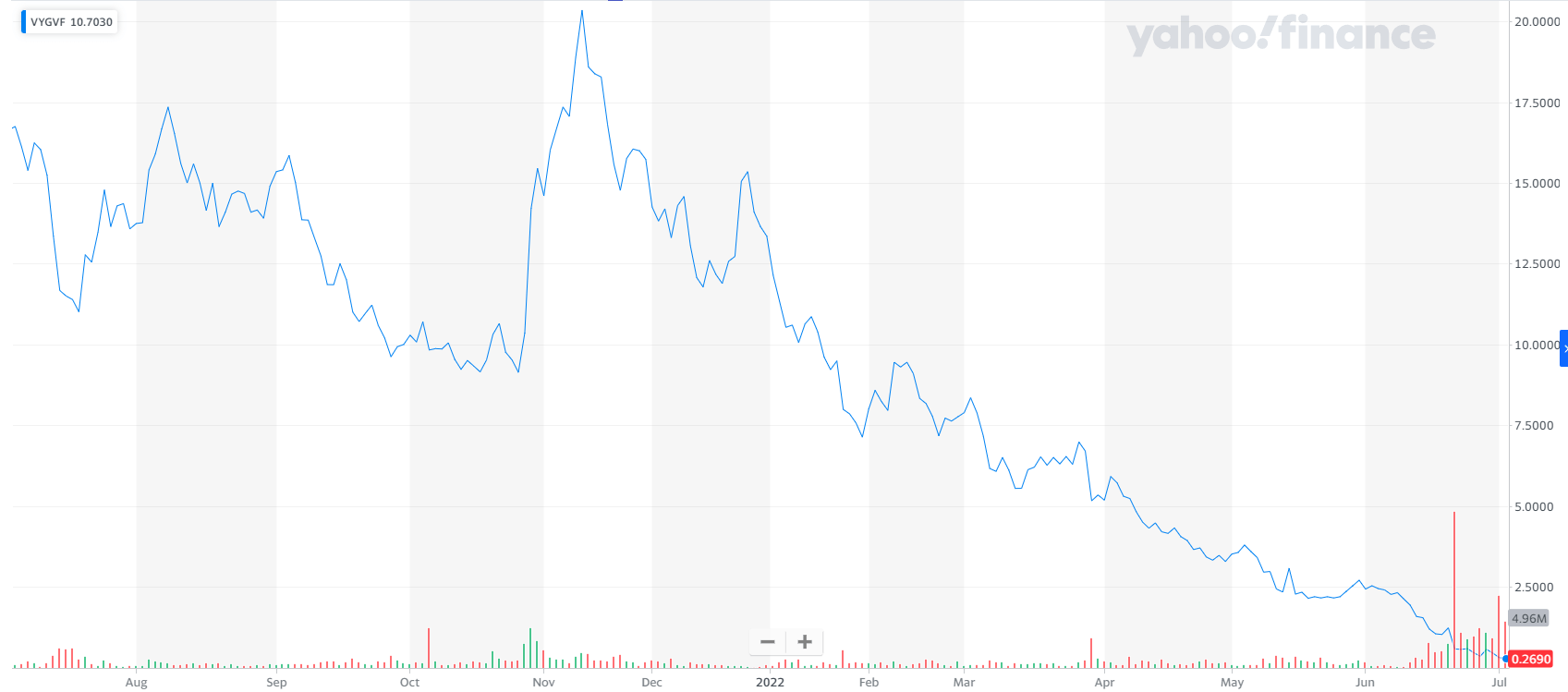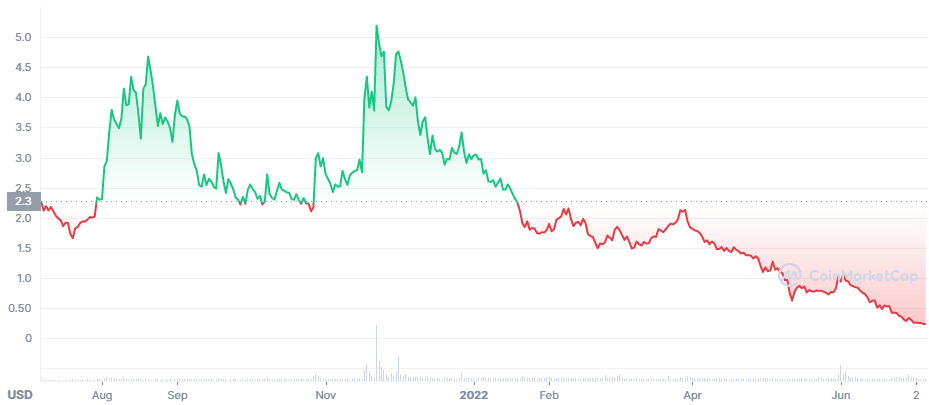Share

CRYPTO MARKET PLUNGE: Voyager Digital Follow-Up
On 1 July, cryptocurrency platform and broker Voyager Digital announced their intentions to suspend all deposits, withdrawals and trading activities. This decision was largely driven by Voyager Digital’s exposure to the contagion surrounding Three Arrows Capital (3AC). Voyager Digital issued a notice of default to 3AC, who became unable to meet their margin calls and subsequently filed for bankruptcy due to recent cryptocurrency price action. Following this news, Voyager Digital’s share price fell over 43% on the Toronto Stock Exchange (TSE), with the 1 year chart seen below.

Regarding Voyager Digital’s decision, CEO Stephen Ehrlich had this to say:
“This was a tremendously difficult decision, but we believe it is the right one given current market conditions,” - Stephen Ehrlich, CEO of Voyager Digital.
Voyager Digital is a New York City-based cryptocurrency platform which offers services such as crypto-asset trading, staking, yield products, and issues a governance token called the Voyager Token ($VGX; 1 year price chart below, currently trading at $0.24 as of 6/7/22).

On 22 June, Voyager Digital announced that it had approximately $700 million worth of exposure to 3AC, which is comprised of 15,250 bitcoins and 350 million USDC. 3AC had previously suffered from huge losses due to their exposure to Terra-LUNA, which had crashed during May 2022.
This led to Alameda Research, a company fronted by FTX CEO Sam Bankman-Fried, entering into a $500 million loan agreement with Voyager Digital. In particular, the credit terms offered by Alameda Research include a first credit facility denominated in cash/USDC, with an aggregate principal amount of $200 million USD, and a second revolving credit facility denominated in bitcoin, with an aggregate principal amount of 15,000 bitcoin in the event Voyager Digital needs to safeguard customer assets. However, there are doubts surrounding the intentions and overall structure of Alameda’s loans and Voyager Digital’s position.
Looking ahead, it will be interesting to see how the fall-out from the Terra-LUNA collapse and 3AC will continue to plague the cryptocurrency market. Elsewhere, embattled cryptocurrency custody platform BlockFi has received a $250 million offer from Morgan Creek Digital to purchase a majority stake in it, and an offer from Bankman-Fried’s FTX for a revolving credit facility worth $250 million in light of its financial distress. Since Alameda Research sold large quantities of Lido staked Ethereum (stETH) and bought Ethereum, they had a sizable involvement in de-pegging stETH and subsequently destabilising many crypto-institutions.
As a result of this, some market observers theorise that Bankman-Fried may be making an opportunistic play to build a larger market presence via finance of newly financially distressed crypto-institutions that have been affected by the de-pegging of stETH and Terra-LUNA.
EUROPEAN REGULATION: Markets in Crypto Assets Regulatory Proposal Follow-Up
On 30 June, the Council of the European Union reported that a provisional agreement was reached by European Union (EU) officials regarding the Markets in Crypto-Assets (MiCA) proposal. With this agreement, Europe has become the first continent to introduce crypto-asset regulation, as proclaimed by Stefan Berger in a tweet, a Member of the European Parliament and the parliamentarian in charge of the regulatory package:
“Europe is the first continent with crypto asset regulation,” - Stefan Berger, Member of the European Parliament.
The MiCA proposal, in development since September 2020, aims to protect investors and establish standards for stablecoin issuers for citizens of all 27 states of the EU. Regarding the contents of the regulatory package, a notable inclusion pertains to the capping of large stablecoins that are not tied to a single fiat currency as a means of payment, as a daily transaction volume cap of 200 million Euros per day will be implemented. This could prevent widespread adoption of stablecoins in Europe, considering that the biggest four stablecoins all have daily transaction volumes that exceed $200 million per day. Furthermore, non-fungible tokens (NFTs) will not be included in the regulation, unless they can be split apart or fractionalised.
A notable omission from the regulatory framework pertains to the controversial proposal to restrict the use of cryptocurrencies that use a proof-of-work (PoW) consensus mechanism from January 2025. Subsequently struck down, this was a proposed addition to the regulatory framework following concerns about the implications of Bitcoin’s annual energy consumption, and how it could be reasonably compared to that of whole countries, given today’s context of climate change and global warming. This proposal was viewed negatively by crypto-asset proponents, who argued that the key issue regarding PoW mining was not the quantity of energy consumed by the network, but the carbon intensity of the energy sources used to power PoW mining rigs.
From here, for this regulatory framework to be implemented within the European Union’s individual states, the MiCA will need to have the parliamentary and governmental approval of the individual states themselves. As such, it will be worth observing how negotiations between individual European states play out over the next few weeks.
The content, presentations and discussion topics covered in this material are intended for licensed financial advisers and institutional clients only and are not intended for use by retail clients. No representation, warranty or undertaking is given or made in relation to the accuracy or completeness of the information presented. Except for any liability which cannot be excluded, Monochrome, its directors, officers, employees and agents disclaim all liability for any error or inaccuracy in this material or any loss or damage suffered by any person as a consequence of relying upon it. Monochrome advises that the views expressed in this material are not necessarily those of Monochrome or of any organisation Monochrome is associated with. Monochrome does not purport to provide legal or other expert advice in this material and if any such advice is required, you should obtain the services of a suitably qualified professional.
Related Articles

Monochrome Partners with Galaxy Digital for Total Bitcoin Wealth Management
Monochrome Capital, a related entity of the investment manager of the Monochrome Bitcoin ETF (IBTC), today announced a strategic partnership with Galaxy Digital to deliver comprehensive Bitcoin wealth management solutions for institutional clients.

IBTC Integrated into Bitcoin-Backed Mortgages for Qualifying High-Net-Worth Investors
The Monochrome Bitcoin ETF (IBTC) has been incorporated into a Top 4 Australian bank’s residential mortgage lending framework. IBTC is now recognised alongside traditional assets such as unencumbered property and income streams when assessing high-net-worth (HNW) investors for home loans. This development connects regulated Bitcoin ETFs with private banking services, enabling Bitcoin holders to access property financing without liquidating their exposure.